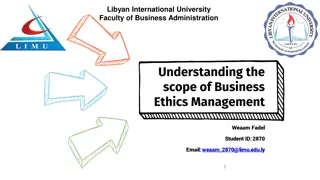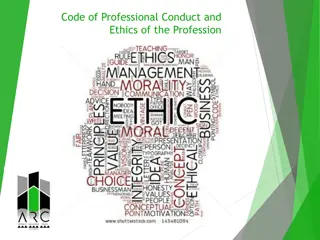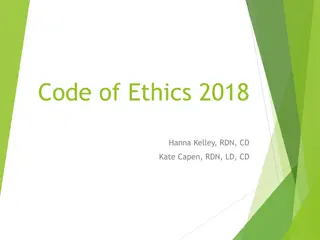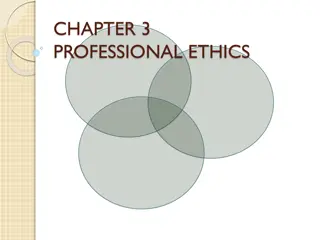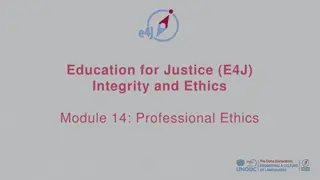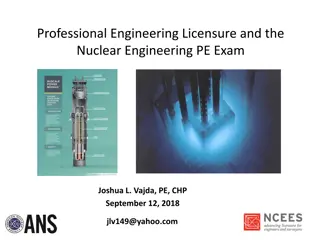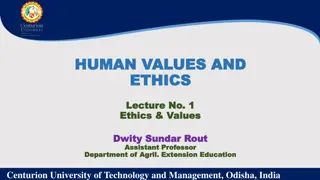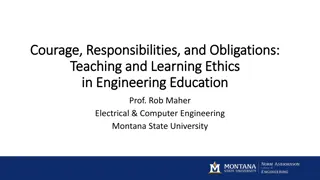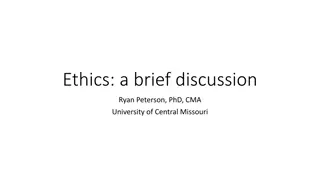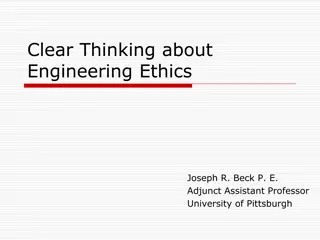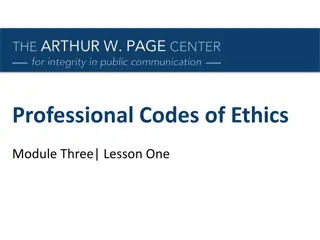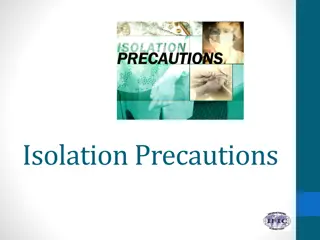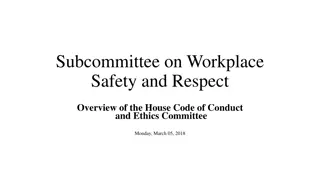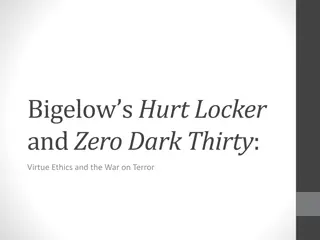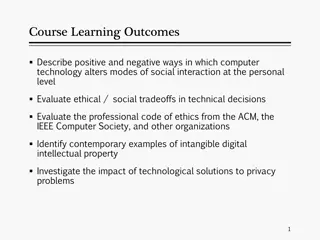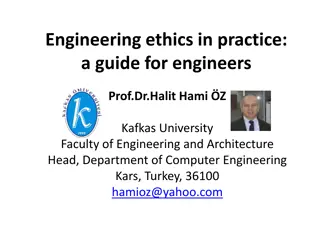Safety in Engineering: Professional Ethics, Regulations, and Precautions
This content discusses various aspects of safety in engineering, including professional ethics, regulations, and safety precautions in different settings like generator rooms, broadcast sites, and studios. It covers topics such as the importance of safety, professional conduct, registration with engineering bodies, government regulations, contract documents, and safety rules to prevent accidents. It emphasizes the significance of safety in engineering practices and the responsibility of engineers to ensure the well-being of personnel and property.
Download Presentation

Please find below an Image/Link to download the presentation.
The content on the website is provided AS IS for your information and personal use only. It may not be sold, licensed, or shared on other websites without obtaining consent from the author. Download presentation by click this link. If you encounter any issues during the download, it is possible that the publisher has removed the file from their server.
E N D
Presentation Transcript
2019 HOEC SAFETY IN ENGINEERING Engr. Stephen Ogu Moses Ph.D FNSE Engr. S.O. Moses FNSE 1
Practice Questions 1. (a) A professional broadcast engineer on a multi-million naira project had a disagreement with the contractor on certain technical aspect of the work and both parties failed to reach a conclusion. Some days later, the contractor offered an all expenses paid trip to United Kingdom to the Engineer to make-up for the disagreement. Is it ethical for him to collect such an offer? Discuss your position. (b) (i) Why should an engineer register with professional body? (ii) What are the steps you will take to ensure that you are registered? (iii) Name the government agency responsible for the regulation of engineering practice in Nigeria. 2. (a) Highlight the objectives of 2007 procurement Act . (b) Define and state the roles of the different cadres of the engineering family. Engr. S.O. Moses FNSE 2
3. (a) Define the following contract document Contract drawings The specifications General conditions of contract BEME Tender (b) Highlight key site personnel for the contractor in organization chart and explain their roles in engineering project. 4. Highlight sources of accidents and suggest safety precautions to take in the following places: (i) Generator and Power room. (ii) Outside Broadcast site (iii) Transmitter Site (iv) Studio & MCR Engr. S.O. Moses FNSE 3
Agenda Today s session will cover: What is Safety Why is safety important Accidents, Dangerous Occurrences. Engr. S.O. Moses FNSE 4
What is Safety As freedom from danger, hazard, injury, harm or damage; security. Relative freedom from danger, risk, or threat of harm, injury or loss to personnel and or property, whether caused deliberately or by accident. Is of utmost importance to anyone in or around an engineering workshop. Engineering is to add quality to life & not to take lives. Engr. S.O. Moses FNSE 5
What is Safety The minimization of contact between human & hazard and is predominantly concerned with the prevention of physical harm to persons or property. As a positive, organized activity or programme based on knowledge of the reaction between man and his working environment, which aids business enterprise by minimizing death, losses caused by injuries, health impairment, fires, explosion and other occupational accidents. Opposite of danger. Engr. S.O. Moses FNSE 6
SAFETY RULES If the environment is not safe, don t work. If the machines, tools and equipment are not safe, don t work. If the personal safety equipment is not provided, don t work. Engr. S.O. Moses FNSE 7
Accidents & Workshop Safety Engineering workshop is generally a hazardous environment. Injury to persons Damage to equipment Damage to the environment Engr. S.O. Moses FNSE 8
Accidents & Workshop Safety What are accidents?. Event that takes place without expectation. A happening by chance. Unexpected event, which may or may not cause any injury. A mishap Engr. S.O. Moses FNSE 9
Why safety is important? Legal requirement Expensive compensation claims Criminal prosecutions or other enforcement action by Health & Safety Authority. As an essential area of professional competence & responsibility. Engr. S.O. Moses FNSE 10
Why does it matter? Safe working protects: You Other lab workers Cleaners Visitors Your work Engr. S.O. Moses FNSE 11
What does the law say? (1) Health Safety at Work etc Act 1974 You must work safely You must not endanger others You must not misuse safety equipment Penalty up to 2 year in prison &/or an unlimited fine Engr. S.O. Moses FNSE 12
What does the law say? (2) The Management of Health and Safety at Work Regs 1999 Control of Substances Hazardous to Health Regs 2004 You must perform RISK ASSESSMENTS Engr. S.O. Moses FNSE 13
Accidents & Workshop Safety Causes of accidents Human Factor. Environmental Factor. Force Majeure. Engr. S.O. Moses FNSE 14
Accidents & Workshop Safety HUMAN FACTOR Negligence. Haste in doing the work. Using a wrong tool for a particular job. Not obeying safety regulations. Wrong postures in the workshop. Stepping on obstructions. Using a machine without adequate instruction. Managing faulty machine, or tool. Engr. S.O. Moses FNSE 15
Accidents & Workshop Safety Environmental Factor Heavy & torrential rainfall. Changes in weather conditions. High intensity sunshine. Extremely cold weathers. Engr. S.O. Moses FNSE 16
Accidents & Workshop Safety Force Majeure War , revolution, general labour strikes, diseases, epidemics, extraordinary floods, overflow of water, unidentifiable wild fires, or other events beyond the control of the supervisors. Engr. S.O. Moses FNSE 17
Accidents & Workshop Safety WORKSHOP RULES Keep the workshop clean & tidy at all times. Always seek instruction before using an unfamiliar piece of equipment. Only use tools and machines for their intended purpose. Report all damaged equipment and do not use it until it has been repaired by a qualified person. Never distract the attention of attention of another staff member when that person is operating equipment. Engr. S.O. Moses FNSE 18
Accidents & Workshop Safety WORKSHOP RULES Always use the appropriate personal protective devices & check that they are clean & in good repair before & after use. Long hair needs to be restrained by either a tie or hat. Dangling necklaces, jewelleries and neck ties should not be used in workshops. Dress properly for your physical protection. Use a leather apron, leather glove, & thumb guard. Never use compressed air for cleaning clothing & machinery. Report all hazards & unsafe conditions & work practices. Engr. S.O. Moses FNSE 19
Accidents & Workshop Safety WORKSHOP RULES A regular inspection & maintenance should be in place. Cleaning of machines must not be carried out while they are in motion. Lubrication & adjustment must be carried out only by authorised person. Improvisation of tools not allowed. Defective tools must not be used. Engr. S.O. Moses FNSE 20
Accidents & Workshop Safety WORKSHOP RULES A fully equipped First Aid box should be present & readily accessible. Ensure adequate lighting. Keep all electrical cords & extension cords free of entanglement with loose materials. Keep the floor area clear & wipe up all spilled liquids immediately to prevent a slipping hazard. Engr. S.O. Moses FNSE 21
Accidents & Workshop Safety WORKSHOP RULES Do not use any tools while under the influence of medication, alcohol, or when fatigued. Do not leave any machine unattended with the power on. Make sure the power tool is properly grounded with an appropriate three prong electrical. Engr. S.O. Moses FNSE 22
Protecting yourself Wear the clothing and protective wear identified in your risk assessment Laboratory coats must be kept fastened Don t wear sandals or open shoes Long hair must be tied back Engr. S.O. Moses FNSE 23
Protecting yourself - gloves There are many different types of protective glove Use the correct ones for the job you will be doing Remember that you need to select chemical protection gloves according to the materials and/or substances with which you will be working Remove your gloves before using instruments, telephone, and leaving the laboratory Engr. S.O. Moses FNSE 24
Laboratory hygiene Never eat, drink or smoke in a laboratory Never apply cosmetics Never touch your face, mouth or eyes Never suck pens or chew pencils Always wash your hands before you leave and especially before eating NoFood Engr. S.O. Moses FNSE 25
What are the general hazards in a laboratory? Fire Breakage of glassware Sharps Spillages Pressure equipment & gas cylinders Extremes of heat & cold Chemical hazards Biological hazards Radiation And many more! Engr. S.O. Moses FNSE 26
Avoiding Fires Flammable substances Use minimum quantity Store in special storage cabinet Use temperature- controlled heating sources (eg water-bath rather than hot-plate or Bunsen burner) Engr. S.O. Moses FNSE 27
Minimise fire damage Make sure corridor fire doors and laboratory doors are kept shut at all times Engr. S.O. Moses FNSE 28
Fire Safety Make sure that you know what to do: If you have a fire If you hear a fire alarm If you are a member of staff you must attend fire training annually. Post graduates should also seriously consider doing so. Engr. S.O. Moses FNSE 29
If the fire alarm sounds: 1. Leave the building by the nearest exit point and don t delay to pick up personal belongings. 2. Do not use lifts. 3. Assemble at the Assembly Point for the building. 4. Follow the Fire Stewards instructions and Do Not re-enter the building unless authorised. Engr. S.O. Moses FNSE 30
Familiarise yourself with the location of: the Fire Exits the Fire Alarm Call Point(s) the Assembly Points Engr. S.O. Moses FNSE 31
Accidents & Incidents All accidents and incidents must be reported as soon as possible. Report them to your supervisor or manager. Your supervisor or manager should complete the Accident Report Form or Dangerous Occurrence Form Engr. S.O. Moses FNSE 32
Safety Signs Blue = Compulsory Failure to comply not only puts you at risk, but means that you have broken the law BLUE = Compulsory Failure to comply not only puts you at risk, but means you ve broken the law. Yellow = Warning YELLOW = Warning Failure to take notice could put you at risk. Green = Safe guidance First Aid / Emergency Exits / etc GREEN = Safety guidance First Aid, Emergency Exits Red = Prohibitive or Fire RED =Prohibitive or Fire Engr. S.O. Moses FNSE 33
Glassware Use correct techniques for the insertion of tubing onto glassware Never use glassware under pressure or vacuum unless it is designed for the job and suitably shielded Dispose of chipped or broken glassware it is a risk to you and others Always dispose of broken glass in a glass bin or sharps bin and not in a general waste bin Engr. S.O. Moses FNSE 35
Spillages Clear up spillage promptly You will already have determined how to do this as part of your risk assessment Dispose of any hazardous material as toxic waste Messy workers are usually poor workers!! Engr. S.O. Moses FNSE 36
Gas cylinders Never use without formal training Minimise the number in a laboratory Store externally whenever possible Cylinders are heavy and can do serious damage to you if they fall Ensure that they are chained when in use Move only with a cylinder trolley Use regulators & control equipment suitable for the gas concerned Consider the consequences if your cylinder leaks Engr. S.O. Moses FNSE 37
Electrical Equipment Always do a visual check on electrical equipment before use, looking for obvious wear or defects. NEVER use defective equipment. Engr. S.O. Moses FNSE 38
General Tidiness Keep your workplace tidy Clear up waste, deal with washing up and put things away as you finish with them Make sure everything is safe before you leave things unattended A tidy laboratory avoids accidents to everyone X Engr. S.O. Moses FNSE 39
Laboratory Equipment Never use any laboratory equipment unless you are trained & have been authorised to do so As well as injuring yourself you may cause very costly damage Engr. S.O. Moses FNSE 40
First Aid All laboratory workers should undergo simple first aid training For ALL chemical splashes, wash with plenty of water for 10 minutes Control bleeding with direct pressure, avoiding any foreign bodies such as glass Engr. S.O. Moses FNSE 41
Protecting your health If you have an allergy to lab materials or suffer from a medical condition which may affect you in the laboratory (eg diabetes or epilepsy), ensure that your supervisor knows Engr. S.O. Moses FNSE 42
Waste Materials Part of your risk assessment will be to determine how to dispose of waste lab materials safely Solvents and oils must be segregated into the correct waste bottle or drum Your department will help you determine what to do with chemical or biological materials Do not put materials down the drain or in with normal waste unless authorised to do so Engr. S.O. Moses FNSE 43
When in doubt ASK!!! Do not carry out a new or unfamiliar procedure until you have been fully trained & understand the precautions necessary for safe working DO NOT GUESS!!!! Engr. S.O. Moses FNSE 44
RISK ANALYSIS RISK A situation involving exposure to danger. The possibility that something unpleasant is going to happen. HAZARD A biological, chemical or physical agent in, food with the potential to cause an adverse health effect. A condition or physical situation with a potential for an undesirable consequence. Engr. S.O. Moses FNSE 45
RISK ANALYSIS RISK VERSUS HAZARD Hazard: something with the potential to cause harm. Risk : the likelihood of occurrence and the magnitude of consequences of a specified hazard being realized. Engr. S.O. Moses FNSE 46
RISK ANALYSIS Analytical process to provide information regarding, undesirable events; Process of estimating probabilities and expected consequences for identified risk. Detailed examination including risk assessment, risk evaluation and risk management alternatives, performed to understand the nature of unwanted outcome. A process undertaken to deal with matters which pose a potential danger, managed according to certain standard procedure & that involves : Hazard identification, risk assessment, risk management, risk communication. Engr. S.O. Moses FNSE 47
RISK ANALYSIS Hazard identification Identification of the hazard. Risk assessment. The process of evaluating the risk resulting from a hazard. Engr. S.O. Moses FNSE 48
RISK ANALYSIS Risk management. Based on the results of the risk assessment & the judgment of the risk managers, decisions are taken & policy is formulated. Risk management is the process of weighing alternatives in consultation with all interested parties considering risk assessment & other factors. Risk communication information exchange between risk assessors, risk managers & those affected by both the risk & decisions taken before the final policy decisions are taken. Risk assessment is only part of the whole process of risk analysis Engr. S.O. Moses FNSE 49





